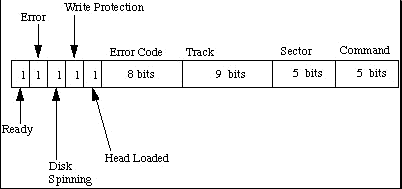C/C++ 位域(Bit Fields)
来源:互联网 发布:陌陌推广软件 编辑:程序博客网 时间:2024/04/29 14:45
今天中午与同事讨论位域的问题,越讨论越迷糊,最终还是求救Google,找到一些文章,把比较好两篇的转载于下。
1. 原文:http://www.cs.cf.ac.uk/Dave/C/node13.html
We have seen how pointers give us control over low level memory operations.
Many programs (e.g. systems type applications) must actually operate at a low level where individual bytes must be operated on.
NOTE: The combination of pointers and bit-level operators makes C useful for many low level applications and can almost replace assembly code. (Only about 10 % of UNIX is assembly code the rest is C!!.)
The bitwise operators of C a summarised in the following table:
DO NOT confuse & with &&: & is bitwise AND, && logical AND. Similarly for ![]() and
and ![]() .
.
![]() is a unary operator -- it only operates on one argument to right of the operator.
is a unary operator -- it only operates on one argument to right of the operator.
The shift operators perform appropriate shift by operator on the right to the operator on the left. The right operator must be positive. The vacated bits are filled with zero (i.e. There is NOwrap around).
For example: x << 2 shifts the bits in x by 2 places to the left.
So:
if x = 00000010 (binary) or 2 (decimal)
then:
![]() or 0 (decimal)
or 0 (decimal)
Also: if x = 00000010 (binary) or 2 (decimal)
![]() or 8 (decimal)
or 8 (decimal)
Therefore a shift left is equivalent to a multiplication by 2.
Similarly a shift right is equal to division by 2
NOTE: Shifting is much faster than actual multiplication (*) or division (/) by 2. So if you want fast multiplications or division by 2 use shifts.
To illustrate many points of bitwise operators let us write a function, Bitcount, that counts bits set to 1 in an 8 bit number (unsigned char) passed as an argument to the function.
This function illustrates many C program points:
- for loop not used for simple counting operation
- x
 x = x >> 1
x = x >> 1 - for loop will repeatedly shift right x until x becomes 0
- use expression evaluation of x & 01 to control if
- x & 01 masks of 1st bit of x if this is 1 then count++
Bit Fields allow the packing of data in a structure. This is especially useful when memory or data storage is at a premium. Typical examples:
- Packing several objects into a machine word. e.g. 1 bit flags can be compacted -- Symbol tables in compilers.
- Reading external file formats -- non-standard file formats could be read in. E.g. 9 bit integers.
C lets us do this in a structure definition by putting :bit length after the variable. i.e.
struct packed_struct { unsigned int f1:1; unsigned int f2:1; unsigned int f3:1; unsigned int f4:1; unsigned int type:4; unsigned int funny_int:9;} pack;
Here the packed_struct contains 6 members: Four 1 bit flags f1..f3, a 4 bit type and a 9 bit funny_int.
C automatically packs the above bit fields as compactly as possible, provided that the maximum length of the field is less than or equal to the integer word length of the computer. If this is not the case then some compilers may allow memory overlap for the fields whilst other would store the next field in the next word (see comments on bit fiels portability below).
Access members as usual via:
pack.type = 7;
NOTE:
- Only n lower bits will be assigned to an n bit number. So type cannot take values larger than 15 (4 bits long).
- Bit fields are always converted to integer type for computation.
- You are allowed to mix ``normal'' types with bit fields.
- The unsigned definition is important - ensures that no bits are used as a
 flag.
flag.
Frequently device controllers (e.g. disk drives) and the operating system need to communicate at a low level. Device controllers contain several registers which may be packed together in one integer (Figure 12.1).

Fig. 12.1 Example Disk Controller Register We could define this register easily with bit fields:
struct DISK_REGISTER { unsigned ready:1; unsigned error_occured:1; unsigned disk_spinning:1; unsigned write_protect:1; unsigned head_loaded:1; unsigned error_code:8; unsigned track:9; unsigned sector:5; unsigned command:5;};
To access values stored at a particular memory address, DISK_REGISTER_MEMORY we can assign a pointer of the above structure to access the memory via:
struct DISK_REGISTER *disk_reg = (struct DISK_REGISTER *) DISK_REGISTER_MEMORY;
The disk driver code to access this is now relatively straightforward:
/* Define sector and track to start read */disk_reg->sector = new_sector;disk_reg->track = new_track;disk_reg->command = READ;/* wait until operation done, ready will be true */while ( ! disk_reg->ready ) ;/* check for errors */if (disk_reg->error_occured) { /* interrogate disk_reg->error_code for error type */ switch (disk_reg->error_code) ...... }
Bit fields are a convenient way to express many difficult operations. However, bit fields do suffer from a lack of portability between platforms:
- integers may be signed or unsigned
- Many compilers limit the maximum number of bits in the bit field to the size of an integer which may be either 16-bit or 32-bit varieties.
- Some bit field members are stored left to right others are stored right to left in memory.
- If bit fields too large, next bit field may be stored consecutively in memory (overlapping the boundary between memory locations) or in the next word of memory.
If portability of code is a premium you can use bit shifting and masking to achieve the same results but not as easy to express or read. For example:
unsigned int *disk_reg = (unsigned int *) DISK_REGISTER_MEMORY;/* see if disk error occured */disk_error_occured = (disk_reg & 0x40000000) >> 31;
Exercise 12507
Write a function that prints out an 8-bit (unsigned char) number in binary format.
Exercise 12514
Write a function setbits(x,p,n,y) that returns x with the n bits that begin at position p set to the rightmost n bits of an unsigned char variable y (leaving other bits unchanged).
E.g. if x = 10101010 (170 decimal) and y = 10100111 (167 decimal) and n = 3 and p = 6 say then you need to strip off 3 bits of y (111) and put them in x at position 10xxx010 to get answer 10111010.
Your answer should print out the result in binary form (see Exercise 12.1 although input can be in decimal form.
Your output should be like this:
x = 10101010 (binary) y = 10100111 (binary) setbits n = 3, p = 6 gives x = 10111010 (binary)
Exercise 12515
Write a function that inverts the bits of an unsigned char x and stores answer in y.
Your answer should print out the result in binary form (see Exercise 12.1 although input can be in decimal form.
Your output should be like this:
x = 10101010 (binary) x inverted = 01010101 (binary)
Exercise 12516
Write a function that rotates (NOT shifts) to the right by n bit positions the bits of an unsigned char x.ie no bits are lost in this process.
Your answer should print out the result in binary form (see Exercise 12.1 although input can be in decimal form.
Your output should be like this:
x = 10100111 (binary) x rotated by 3 = 11110100 (binary)
Note: All the functions developed should be as concise as possible
Classes and structures can contain members that occupy less storage than an integral type. These members are specified as bit fields. The syntax for bit-fieldmember-declarator specification follows:
declaratoropt : constant-expression
The declarator is the name by which the member is accessed in the program. It must be an integral type (including enumerated types). The constant-expressionspecifies the number of bits the member occupies in the structure. Anonymous bit fields — that is, bit-field members with no identifier — can be used for padding.
Note An unnamed bit field of width 0 forces alignment of the next bit field to the next type boundary, where type is the type of the member.
The following example declares a structure that contains bit fields:
// bit_fields1.cppstruct Date{ unsigned nWeekDay : 3; // 0..7 (3 bits) unsigned nMonthDay : 6; // 0..31 (6 bits) unsigned nMonth : 5; // 0..12 (5 bits) unsigned nYear : 8; // 0..100 (8 bits)};int main(){}The conceptual memory layout of an object of type Date is shown in the following figure.
Memory Layout of Date Object

Note that nYear is 8 bits long and would overflow the word boundary of the declared type, unsigned int. Therefore, it is begun at the beginning of a newunsigned int. It is not necessary that all bit fields fit in one object of the underlying type; new units of storage are allocated, according to the number of bits requested in the declaration.
Microsoft Specific
The ordering of data declared as bit fields is from low to high bit, as shown in the figure above.
END Microsoft Specific
If the declaration of a structure includes an unnamed field of length 0, as shown in the following example,
// bit_fields2.cppstruct Date{ unsigned nWeekDay : 3; // 0..7 (3 bits) unsigned nMonthDay : 6; // 0..31 (6 bits) unsigned : 0; // Force alignment to next boundary. unsigned nMonth : 5; // 0..12 (5 bits) unsigned nYear : 8; // 0..100 (8 bits)};int main(){}the memory layout is as shown in the following figure.
Layout of Date Object with Zero-Length Bit Field

The underlying type of a bit field must be an integral type, as described in Fundamental Types.
- C/C++ 位域(Bit Fields)
- C/C++位域(Bit-fields)
- C/C++位域(Bit-fields)
- C/C++位域(Bit-fields)
- C/C++ 字节序/位域(Bit-fields)之我见
- 【转】 C/C++位域(Bit-fields)之我见
- C/C++位域(Bit-fields)之我见
- C/C++位域(Bit-fields)之我见
- C/C++位域(Bit-fields)之我见
- C/C++位域(Bit-fields)操作的问题
- C/C++位域(Bit-fields)之我见(不错)
- C/C++ 字节序/位域(Bit-fields)之我见
- C/C++ 字节序/位域(Bit-fields)
- 位域的定义和使用 C Bit Fields
- C 结构体之位域(位段) | C Bit Fields
- 位域(bit fields)
- C Bit Fields
- C语言中结构体的位域(bit-fields)
- __declspec(novtable) 的用法
- poj_1068的经验
- 编写完成端口网络服务器的一些说明
- 加强视频,关于泛型
- Vector、ArrayList和List的异同(转)
- C/C++ 位域(Bit Fields)
- IOCP配合AcceptEx的例子
- Viewstamps算法
- Ext4文件系统和Ext3文件系统性能对比
- HTTP多线路断点续传
- Javascript打开新页面
- Structured Exception Handling (1)
- All The Cheat Sheets That A Web Developer Needs
- java编程规范


